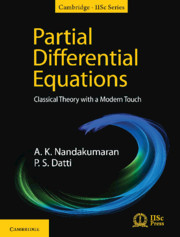Book contents
- Frontmatter
- Dedication
- Contents
- List of Illustrations
- Preface
- Acknowledgments
- Notations
- Chapter 1 Introduction
- Chapter 2 Preliminaries
- Chapter 3 First-Order Partial Differential Equations: Method of Characteristics
- Chapter 4 Hamilton–Jacobi Equation
- Chapter 5 Conservation Laws
- Chapter 6 Classification of Second-Order Equations
- Chapter 7 Laplace and Poisson Equations
- Chapter 8 Heat Equation
- Chapter 9 One-Dimensional Wave Equation
- Chapter 10 Wave Equation in Higher Dimensions
- Chapter 11 Cauchy–Kovalevsky Theorem and Its Generalization
- Chapter 12 A Peep into Weak Derivatives, Sobolev Spaces and Weak Formulation
- References
- Index
Chapter 7 - Laplace and Poisson Equations
Published online by Cambridge University Press: 20 May 2020
- Frontmatter
- Dedication
- Contents
- List of Illustrations
- Preface
- Acknowledgments
- Notations
- Chapter 1 Introduction
- Chapter 2 Preliminaries
- Chapter 3 First-Order Partial Differential Equations: Method of Characteristics
- Chapter 4 Hamilton–Jacobi Equation
- Chapter 5 Conservation Laws
- Chapter 6 Classification of Second-Order Equations
- Chapter 7 Laplace and Poisson Equations
- Chapter 8 Heat Equation
- Chapter 9 One-Dimensional Wave Equation
- Chapter 10 Wave Equation in Higher Dimensions
- Chapter 11 Cauchy–Kovalevsky Theorem and Its Generalization
- Chapter 12 A Peep into Weak Derivatives, Sobolev Spaces and Weak Formulation
- References
- Index
Summary
INTRODUCTION
The reasons for studying Laplace and Poisson equations are twofold.Primarily, these equations arise in a wide variety of physical contexts.Secondly, as mentioned earlier, Laplace operator is a prototype of a verygeneral class of linear elliptic operators. In fact, the Laplace operatorpossesses many features of the general class of elliptic operators. Recallthat the most general form of second-order linear partial differentialequations (PDE) in n variables is given by
where x ∈ Ω; an open set inℝn,aij = aji. Theoperator L is said to be uniformlyelliptic if there exists an a > 0 suchthat for all. Recall that is the characteristic form associated with theoperator L. The ellipticity condition here implies that thecharacteristic variety is an empty set at all points in Ω.
Thus, the condition requires the uniform positive definiteness of thesymmetric matrix [aij(x)]. Ifwe take bi = ci =d = 0 and
there results the Laplace operator Δ. The ultimate interest is tostudy the classical solutions of the equationLu=f for a given dataf. The study of Laplace equationΔu=0 and Poisson equationΔu = f (potentialtheory) gives a starting point for the general theory ofLu = f. The Schaudertheory provides a general theory for Lu =f when the coefficients are smooth, that is,Hölder continuous and it is essentially an extension of the potentialtheory. The crucial result is the derivation of estimates (known asa-priori estimates), say, of the form: Anyu ∈ C2(Ω), asolution of Δu = f in adomainΩ ⊂ℝn satisfies a uniform estimate:
where Ω′ ⊂⊂Ω; 0 < a < 1 andC is a constant depending only on a.Here is the standard Ḧolder space.
Such estimates eventually (with delicate analysis) lead to the solvability ofthe equation. The above estimate is an interior estimateand we also require boundary/global estimates that depend on the smoothnessof the boundary as well.
- Type
- Chapter
- Information
- Partial Differential EquationsClassical Theory with a Modern Touch, pp. 166 - 215Publisher: Cambridge University PressPrint publication year: 2020



